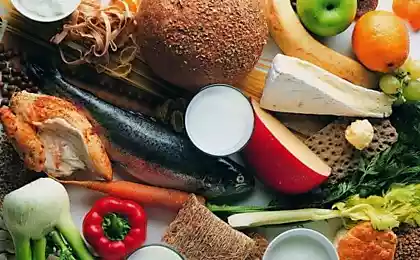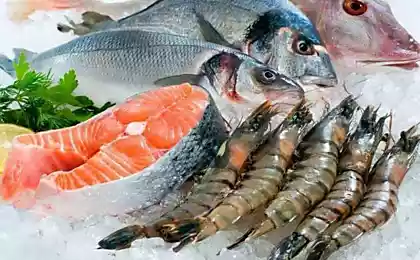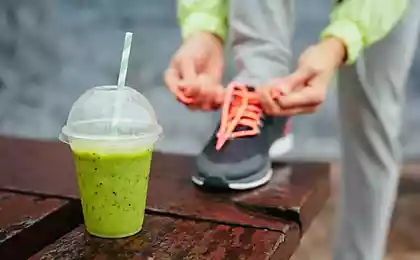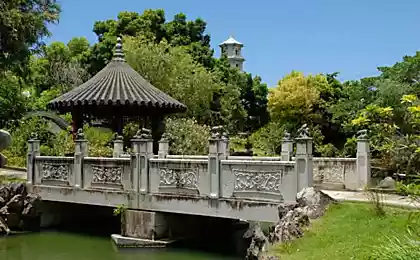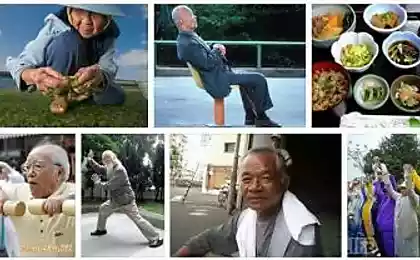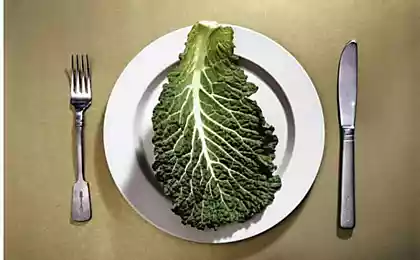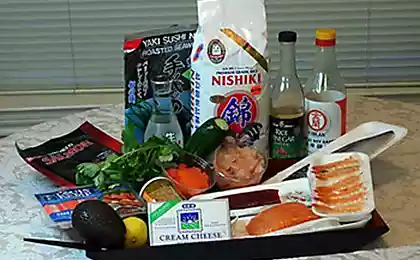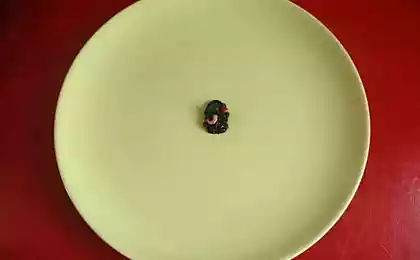858
10 principles of nutrition centenarians of Okinawa
Sensation of Okinawa began in 1979, when the administration of the Institute Guinness sent there at the request of the journalist to interview the oldest man on earth — according to official figures, at that time — Mr. Izumi. This very elderly man (and he "knocked" for 115 years) was very cheerful and youthful look. Yes, and his neighbors also complained about health. Men here live on average to 88 years, women — 92 years-10-15 years longer than in the rest of Japan. This figure is higher srednekamennogo, and the Japan ranks first in the world.
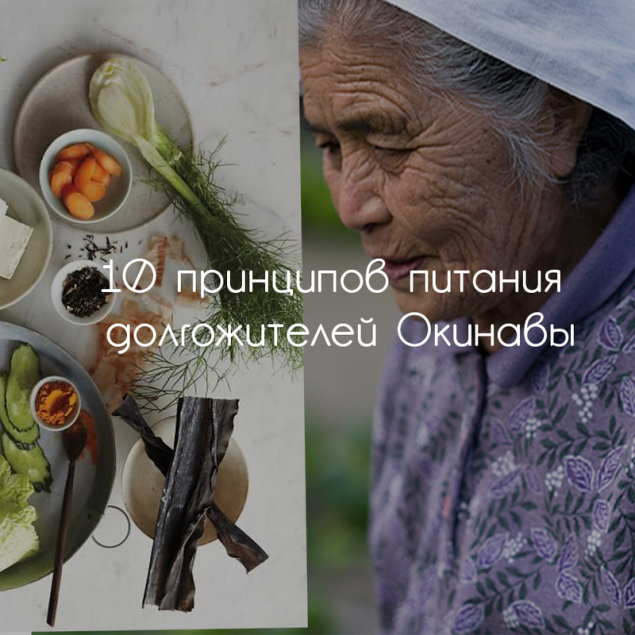
In addition to high life expectancy, the islanders have a low mortality from cardiovascular disease and some cancers. During research in 1995, the year it was found that compared with Americans of the same age the Okinawans are 8 times less likely to die from coronary heart disease, 7 times less from prostate cancer, 6.5 times less than from breast cancer, and 2.5 times less likely to die from colon cancer. Most interesting is their health throughout life. The majority of Okinawans, who was executed hundred years and more, remained throughout life is surprisingly healthy. Physical and mental abilities 80-year-old differed from the abilities of 40-year-old. The levels of estrogen and testosterone they were the same! Only a couple of years before his death, scientists observed long-lived "expeditiously" passed through the stages of aging with their ugly sides. Mature years they spent just, actively and spiritually. Unlike the Caucasian mountaineers, hunzakuts Northern Pakistan, and other Nations, famous for their longevity, Okinawan, all acts of birth, starting in 1879, documented in the Japanese family registry — kosaki. Seeing that was worth the Okinawans move to other countries as they ceased to live long, the researchers Suzuki and Wilcox understand that their longevity genetic factor is not important and that the secret to Okinawan longevity rests on four pillars:
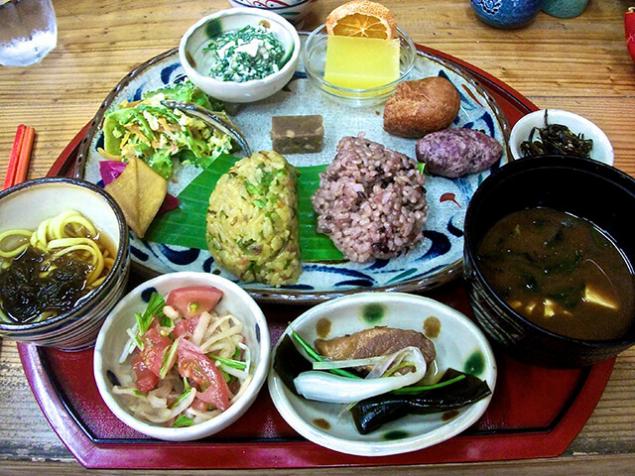
Principle 1. The food culture. In Okinawan dialect there is a word "Cosimo", translated as "health food." Their diet, being much more nutritious than the Western and traditional Japanese, 40% less calories than the first, and by 20% than the second. The principle of power is called gasai– food as medicine. For Okinawans "good" to eat means to enjoy any of the delicacies, and to eat is the traditional set of products, which they consider most beneficial for the body. This principle originated in ancient times. This effect creates the atmosphere of the island, where the practice of healthy lifestyle, positive thinking, kindness, slow the Patriarchal way of life. Great place have traditionally been the food. Local greeting is: "aren't You eating well?" On the island of Okinawa to the process of the meal is treated with great respect. Although take food frequently and in small portions, every single meal is a real meal at a beautifully laid table, in the presence of all family members and effortlessly. Great attention is given adequate time for meals, this contributes to a large number of dishes, served separately, using chopsticks, quiet mood, the strict ritual of food.
The Okinawans believe that food eaten in a bad mood can only do harm. No wonder they say that the source of thousands of diseases restless mind.
Live okinavsky means to rejoice every single day. This is a complete and self-sufficient existence, which is based on local customs, traditions and ancient teachings of Zen.
And in Okinawa it is not customary to eat alone. "Norai" custom "to break bread" in the company of friends and nice people is sacred for many generations of local residents.
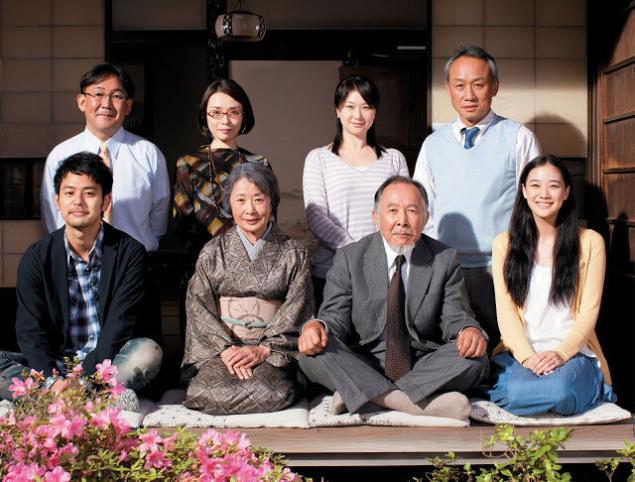
Japanese prayer before the meal:People gather filled with joy;Food and drink galore.With each generation, day by nastanovich better,And after a myriad of letrazole to no end. Principle 2. Healthy specific calorie intake. This principle is simple. In their courses, I refer to him as "rich" and "poor calories". The Central concept of the diet of Okinawa – density calorie foods, i.e. calories per gram. For clarity, we define the density of the hamburger:
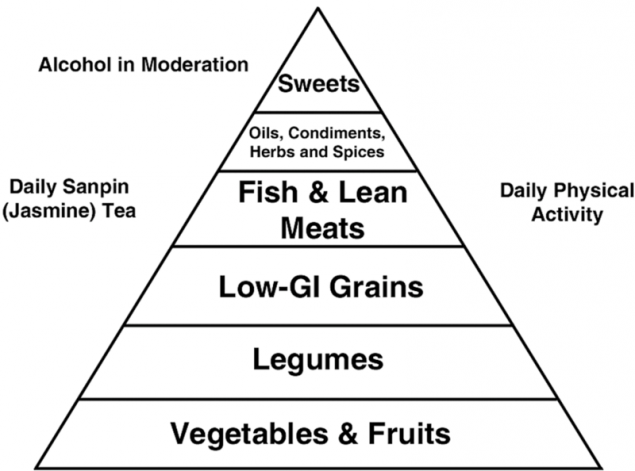
Principle 3. The principle is satisfying and without overeating. In fact, the development of the previous principle. It is important to have satisfying. Eating habits of residents of Okinawa is called Hara hachi BU which means to eat 80% and a fixed habit to consume antioxidant-rich foods. In fact, it does not mean you have to get up hungry. The idea that you need to get up from the table hungry, vicious and wrong. Look at the photo of the rations, will you be hungry after that?
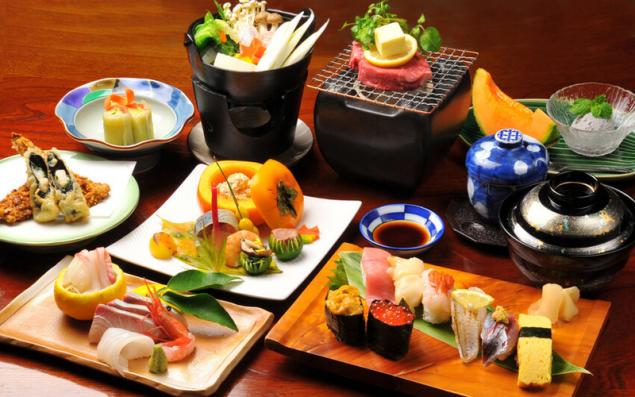
Yes, in General, the numbers of caloric intake in Okinawa is less than the European, but once you make allowances for the weight of Japanese and European, it won't make a difference! It is very important to eat much, but don't overeat. Ie you would still have to eat, but you are already full. Factors of satiety much: it and a lot of fiber, foods with low specific calorie soup at the beginning of the meal, long power time and more number of factors . Sensitive to stretching and signaling of satiety receptors in the stomach takes about 20 minutes to realize – ate enough and more is redundant. The Japanese eat a lot of foods in small portions. They also use chopsticks, which helps to eat food more slowly giving the body more time to feel full. For most soups all the ingredients and broth are cooked separately from each other and incorporate just before serving. It is noteworthy that the soups, the Japanese eat with chopsticks, catching the first pieces of vegetables and meat. Then drink the broth straight from the Cup. Soups broth-based are served at the beginning of each meal, as it was shown in studies that helps to reduce the total amount consumed during a meal calories and to accelerate the feeling of satiety. Principle 4. A healthy carbohydrates. Carbohydrates is an important difference in Okinawa. They eat less rice, less wheat. To replace the rice is sweet potatoes, but the noodles are not wheat, and buckwheat (soba). Interestingly, in General, the diet of Okinawa is considered to be high carbohydrate, since carbohydrates make up 85% of the total number consumed by the islanders of calories. Then there are protein — 9% fat — 6%. The traditional diet of Okinawans 30% consists of vegetables, mostly yellow and green colors. Also in the menu there is rice, but not in such large quantities as those of other Japanese. Residents of the island prefer rice sweet potatoes — it is the basis of their diet. Unlike the rest of the Country of the rising sun here for a long time do not survive Fig. And a real salvation for the locals was imported from southern China IMO is the alpha and omega Okinawan cuisine, the main source of carbohydrates. Since ancient times, when three or four times a year, the archipelago ironed typhoons, destroying rice fields and other landing, hiding deeper IMO survived and saved the Okinawans from hunger. Note that the kinship of our exotic tuber and sweet potato is not obvious. Even though it is sometimes called American or sweet potatoes, it refers to a completely different family — unkovich. Moreover, he substantially wins on all counts. Unlike potatoes, which have edible tubers, sweet potato is a root vegetable. On the beneficial properties of sweet potatoes compares favorably with the ordinary. Sweet potato contains about the same amount of carotene as carrots, and just less than half of ascorbic acid than oranges. In addition, it features folic acid, b vitamins, vitamin E, pectin, cellulose and mineral salts. Content of carbohydrates, calcium and iron sweet potatoes are also markedly superior to the potato. And also discovered proteins that provide long-term storage. Recently, the sweet potato was included in the list of "antidiabetic" food because of its capacity to stabilize the level of blood glucose and reduce insulin resistance.
"Ancient" carbohydrates and fats
"Modern" carbohydrates and fats
Density
Low density carbohydrates, 5% Apple, 30% in the roots. Low density of fat meat – no more than 6% fat.
High density carbohydrates
flour – 90% starch. The high density of purified fats, the modern pork – up to 30% fat.
Composition
"Cell" starches, vegetables, fruits and tubers. Saturated fats, a sufficient amount of omega-3 and omega-6.
"Non-cellular" starches of cereals and legumes in the processed form. Fats: TRANS fats, excess omega 6 and lack of omega-3.
Treatment
Low level thermal and mechanical processing. Moderate heat treatment of fat.
A high level of thermal and mechanical treatment, partial decomposition of starch. Heat treatment fat.
The context
Low degree of purification, a lot of fiber, antioxidants, bitter and sour
High degree of purification, low in fiber and antioxidants, added fat, salt, flavors and flavor enhancers 5. Seafood. In Okinawa they eat a lot of animal and plant seafood. Not do they without fish: it eat here on average 3 times a week. Seafood in honor squids and octopuses. A large part of freshwater and marine fish should marinate for about 30 minutes before cooking grill. The exception is oily fish with a strong flavor, such as amberjack, bluefin tuna, salmon, mackerel, mullet, Marlin, or even our river catfish, which can marinate 4 hours or more. Practice has shown that longer marinating fatty fish makes it taste even better. Our marinade Japanese style, not too sour, because it uses citrus juice, not vinegar, which can-marinated fish for a short time. While fresh ginger gives a special appearance, aroma and taste to the whole dish.
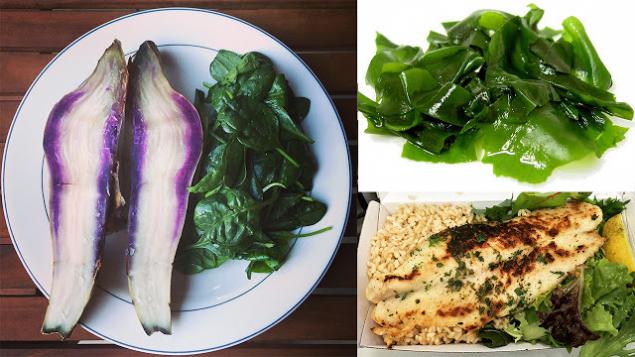
Especially popular seaweed – kombu. Seaweed is often added to dishes of pork, with which it blends well. Almost no calorie, rich in iron, iodine and calcium, kombu is an excellent source of natural fiber. Similar properties have other seaweed grown off the coast of Okinawa: crispy Mozuku, transparent Asa, spiny sea language My sea grapes. The algae are dried, pickled in vinegar and soy sauce, added to soups and stews, meat dishes, fish and shellfish. An indispensable part of the traditional cuisine of countries with hot and humid climate, which include Okinawa are the spices that help prevent quick spoilage. Principle 6. Greens, vegetables and fruits. Antioxidants are obtained from vegetables; very popular bitter cold zucchini Goy (we have more known as MOMORDICA), which during cooking loses its bitterness, but retains a lot of nutrients. In addition, the food of the people of Okinawa are rich in dietary fibers, which improve glucose tolerance and reduce the risk of diabetes and cancer. Also, the food in Okinawa with the low maintenance of animal fats, for optimum health, the essential fatty acids omega-6 / omega-3 ratio close to 1: 1. This leads to a reduction of viral epidemics, chronic heart disease, cancer, diabetes and arthritis. We must also add that this type of food has a low glycemic index. This means that it does not cause a sharp rise in blood sugar. Food in Okinawa includes sweet potatoes, which replaces the rice, and leafy vegetables like spinach, lettuce, Basil, dill, parsley, etc., root vegetables, and products made from soy tofu and miso. Part of the menu, a lot of medicinal plants, seafood and marine algae. Note, tsukemono – pickled vegetables. For each type of vegetables has its own way of marinating. As the vegetables are not subjected to heat treatment, they retain all the nutrients. Pickled vegetables:
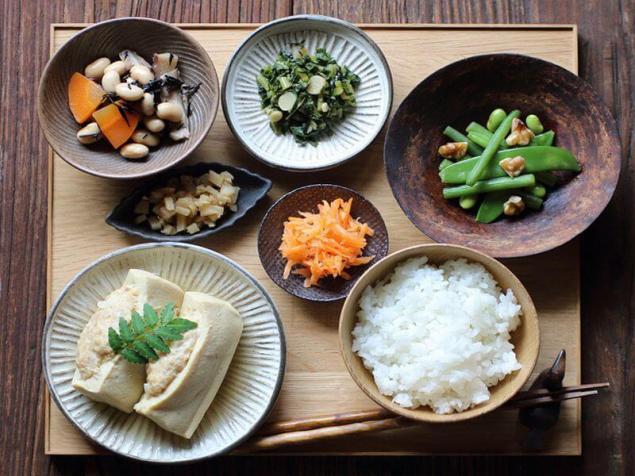
Principle 9. Meat and animal fats. The Okinawans, unlike other Japanese prefer fish to pork, can be eaten in two polar options: dipping raw pork bacon in a soy sauce — like sashimi, or vivaria pork until completely melted fat. But seaweed and soy Okinawans eat much more than other Japanese, but dairy products do not drink at all. But animals products are not more than 20% of the total caloric content of the diet. Despite the fact that the basis of its diet is vegetable, the Okinawans eat meat with gusto, and the main source is pork — in the language of the island of Okinawa meat and pork are one and the same. Pigs from a vast variety of dishes, eating them whole, with tails, ears and noses. One of the favorite dishes is rich soup of pork legs from which is removed most of the fat, the most useful in it is the abundance of sticky collagen and casein, which our supporters a healthy diet regularly anathema. In addition to meat, the island like fish, and unlike the rest of Japan, never eat it raw. Although meat and fish is highly revered by the islanders eat them too often, the diet is still vegetable. Principle 10. Fermented foods. You remember that microorganisms are good. Fermentation – is also our great friend. It makes trudnosmyvaemye products easy for digestion and increases the amount of nutrients. Why is this happening? Friendly microorganisms in the fermentation process break down complex substances into simpler, neutralize plant poisons, preserve, multiply and produce vitamins. Fermented soy products like miso, tempeh, properly prepared soy sauce is extremely useful. A large percentage of phytic acid in them neutralized. Do not abuse soya milk, tofu and low-quality soy sauce. In Okinawa eat a lot of fermented products. Mention tofu (I will emphasize, dense high-protein fermented tofu!). Tofu, made on the island, differs from the traditional higher density. Tofu eat here very often, in fact it is included in every meal. The fermented miso paste. Miso is prepared from legumes, which are fermented together with grain (rice, wheat) and wastes the production of tofu. Fermentation is used barley, wheat, rice, and potato starch and Okara is what remains after making tofu. The fermentation process takes three to six months, so I did it two or three times a year. Almost every one of the many Islands of the Ryukyu archipelago boasts its miso. Not only food single. The social system is very important for health. It is the principles of wemaro and ikigai. Local principle wemaro (our Talaka), which can be translated as "kind and friendly collaborative effort". The atmosphere of mutual support adds to the longevity of peace of mind and optimism that are so necessary in order to enjoy life in old age. When a neighbor needs help in the garden or repair the roof, it comes to half the village, because, as we say, "many hands make light work". Elderly Okinawans involved in all the activities of the community. Even when they come to the school stadium to cheer for other children in the classroom of physical education, it is also wemaro.
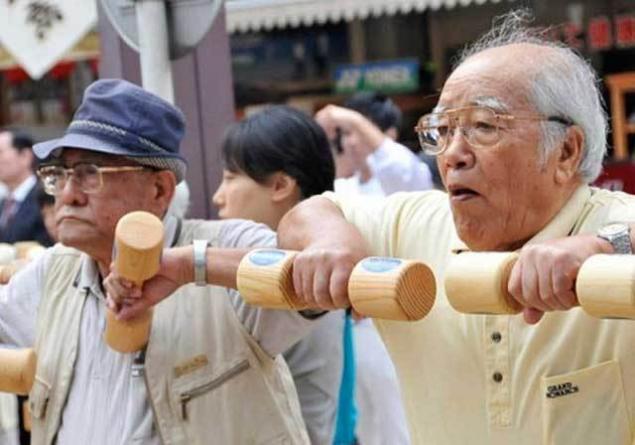
"Every villager contributes a small fee to our municipality for the organization of common Affairs, smiling, says Khan. — I attend classes in ikebana and calligraphy, Michiko engaged in Okinawan dancing, and Misako photography. Old age allows you to try many interesting things." It is not only the number of years, and how the last years are lived. The villagers continue to work the soil almost to the grave. Centenarians and in my spare time don't sit still: they have the circle for weaving baskets, ikebana, calligraphy, karate. Men play a local variety of the croquet ground, it is arranged in every village. There are those who in 80 years, runs a marathon and gets his fish underwater hunting. But most just walk, work in the field and participate in community life. Although elderly Okinawans often live alone, they are adherents of the philosophy wemaro. Moai is a kind of interest groups uniting to 50% of the residents of Okinawa. The principle of ikigai — the reason you get up in the morning out of bed. Some get up to marathons to run, others to great-grandchildren to babysit, and someone moves the responsibility and pride in what he or she is the eldest in the family or in the village. published Author: Andrey Blueskin Also interested in: Okinawa— the world's center of longevity: there are 319 hundred years people Harmful healthy habits according to Japanese Dr. Hiromi Shinya
Source: www.beloveshkin.com/2016/11/10-principov-pitaniya-na-okinave-okinavskaya-dieta.html

In addition to high life expectancy, the islanders have a low mortality from cardiovascular disease and some cancers. During research in 1995, the year it was found that compared with Americans of the same age the Okinawans are 8 times less likely to die from coronary heart disease, 7 times less from prostate cancer, 6.5 times less than from breast cancer, and 2.5 times less likely to die from colon cancer. Most interesting is their health throughout life. The majority of Okinawans, who was executed hundred years and more, remained throughout life is surprisingly healthy. Physical and mental abilities 80-year-old differed from the abilities of 40-year-old. The levels of estrogen and testosterone they were the same! Only a couple of years before his death, scientists observed long-lived "expeditiously" passed through the stages of aging with their ugly sides. Mature years they spent just, actively and spiritually. Unlike the Caucasian mountaineers, hunzakuts Northern Pakistan, and other Nations, famous for their longevity, Okinawan, all acts of birth, starting in 1879, documented in the Japanese family registry — kosaki. Seeing that was worth the Okinawans move to other countries as they ceased to live long, the researchers Suzuki and Wilcox understand that their longevity genetic factor is not important and that the secret to Okinawan longevity rests on four pillars:
- diet
- active lifestyle
- self-sufficiency,
- spirituality.

Principle 1. The food culture. In Okinawan dialect there is a word "Cosimo", translated as "health food." Their diet, being much more nutritious than the Western and traditional Japanese, 40% less calories than the first, and by 20% than the second. The principle of power is called gasai– food as medicine. For Okinawans "good" to eat means to enjoy any of the delicacies, and to eat is the traditional set of products, which they consider most beneficial for the body. This principle originated in ancient times. This effect creates the atmosphere of the island, where the practice of healthy lifestyle, positive thinking, kindness, slow the Patriarchal way of life. Great place have traditionally been the food. Local greeting is: "aren't You eating well?" On the island of Okinawa to the process of the meal is treated with great respect. Although take food frequently and in small portions, every single meal is a real meal at a beautifully laid table, in the presence of all family members and effortlessly. Great attention is given adequate time for meals, this contributes to a large number of dishes, served separately, using chopsticks, quiet mood, the strict ritual of food.
The Okinawans believe that food eaten in a bad mood can only do harm. No wonder they say that the source of thousands of diseases restless mind.
Live okinavsky means to rejoice every single day. This is a complete and self-sufficient existence, which is based on local customs, traditions and ancient teachings of Zen.
And in Okinawa it is not customary to eat alone. "Norai" custom "to break bread" in the company of friends and nice people is sacred for many generations of local residents.

Japanese prayer before the meal:People gather filled with joy;Food and drink galore.With each generation, day by nastanovich better,And after a myriad of letrazole to no end. Principle 2. Healthy specific calorie intake. This principle is simple. In their courses, I refer to him as "rich" and "poor calories". The Central concept of the diet of Okinawa – density calorie foods, i.e. calories per gram. For clarity, we define the density of the hamburger:
- when caloric 280 and the weight of 100 grams and the density will be 280/100 = 2.8.

Principle 3. The principle is satisfying and without overeating. In fact, the development of the previous principle. It is important to have satisfying. Eating habits of residents of Okinawa is called Hara hachi BU which means to eat 80% and a fixed habit to consume antioxidant-rich foods. In fact, it does not mean you have to get up hungry. The idea that you need to get up from the table hungry, vicious and wrong. Look at the photo of the rations, will you be hungry after that?

Yes, in General, the numbers of caloric intake in Okinawa is less than the European, but once you make allowances for the weight of Japanese and European, it won't make a difference! It is very important to eat much, but don't overeat. Ie you would still have to eat, but you are already full. Factors of satiety much: it and a lot of fiber, foods with low specific calorie soup at the beginning of the meal, long power time and more number of factors . Sensitive to stretching and signaling of satiety receptors in the stomach takes about 20 minutes to realize – ate enough and more is redundant. The Japanese eat a lot of foods in small portions. They also use chopsticks, which helps to eat food more slowly giving the body more time to feel full. For most soups all the ingredients and broth are cooked separately from each other and incorporate just before serving. It is noteworthy that the soups, the Japanese eat with chopsticks, catching the first pieces of vegetables and meat. Then drink the broth straight from the Cup. Soups broth-based are served at the beginning of each meal, as it was shown in studies that helps to reduce the total amount consumed during a meal calories and to accelerate the feeling of satiety. Principle 4. A healthy carbohydrates. Carbohydrates is an important difference in Okinawa. They eat less rice, less wheat. To replace the rice is sweet potatoes, but the noodles are not wheat, and buckwheat (soba). Interestingly, in General, the diet of Okinawa is considered to be high carbohydrate, since carbohydrates make up 85% of the total number consumed by the islanders of calories. Then there are protein — 9% fat — 6%. The traditional diet of Okinawans 30% consists of vegetables, mostly yellow and green colors. Also in the menu there is rice, but not in such large quantities as those of other Japanese. Residents of the island prefer rice sweet potatoes — it is the basis of their diet. Unlike the rest of the Country of the rising sun here for a long time do not survive Fig. And a real salvation for the locals was imported from southern China IMO is the alpha and omega Okinawan cuisine, the main source of carbohydrates. Since ancient times, when three or four times a year, the archipelago ironed typhoons, destroying rice fields and other landing, hiding deeper IMO survived and saved the Okinawans from hunger. Note that the kinship of our exotic tuber and sweet potato is not obvious. Even though it is sometimes called American or sweet potatoes, it refers to a completely different family — unkovich. Moreover, he substantially wins on all counts. Unlike potatoes, which have edible tubers, sweet potato is a root vegetable. On the beneficial properties of sweet potatoes compares favorably with the ordinary. Sweet potato contains about the same amount of carotene as carrots, and just less than half of ascorbic acid than oranges. In addition, it features folic acid, b vitamins, vitamin E, pectin, cellulose and mineral salts. Content of carbohydrates, calcium and iron sweet potatoes are also markedly superior to the potato. And also discovered proteins that provide long-term storage. Recently, the sweet potato was included in the list of "antidiabetic" food because of its capacity to stabilize the level of blood glucose and reduce insulin resistance.
"Ancient" carbohydrates and fats
"Modern" carbohydrates and fats
Density
Low density carbohydrates, 5% Apple, 30% in the roots. Low density of fat meat – no more than 6% fat.
High density carbohydrates
flour – 90% starch. The high density of purified fats, the modern pork – up to 30% fat.
Composition
"Cell" starches, vegetables, fruits and tubers. Saturated fats, a sufficient amount of omega-3 and omega-6.
"Non-cellular" starches of cereals and legumes in the processed form. Fats: TRANS fats, excess omega 6 and lack of omega-3.
Treatment
Low level thermal and mechanical processing. Moderate heat treatment of fat.
A high level of thermal and mechanical treatment, partial decomposition of starch. Heat treatment fat.
The context
Low degree of purification, a lot of fiber, antioxidants, bitter and sour
High degree of purification, low in fiber and antioxidants, added fat, salt, flavors and flavor enhancers 5. Seafood. In Okinawa they eat a lot of animal and plant seafood. Not do they without fish: it eat here on average 3 times a week. Seafood in honor squids and octopuses. A large part of freshwater and marine fish should marinate for about 30 minutes before cooking grill. The exception is oily fish with a strong flavor, such as amberjack, bluefin tuna, salmon, mackerel, mullet, Marlin, or even our river catfish, which can marinate 4 hours or more. Practice has shown that longer marinating fatty fish makes it taste even better. Our marinade Japanese style, not too sour, because it uses citrus juice, not vinegar, which can-marinated fish for a short time. While fresh ginger gives a special appearance, aroma and taste to the whole dish.

Especially popular seaweed – kombu. Seaweed is often added to dishes of pork, with which it blends well. Almost no calorie, rich in iron, iodine and calcium, kombu is an excellent source of natural fiber. Similar properties have other seaweed grown off the coast of Okinawa: crispy Mozuku, transparent Asa, spiny sea language My sea grapes. The algae are dried, pickled in vinegar and soy sauce, added to soups and stews, meat dishes, fish and shellfish. An indispensable part of the traditional cuisine of countries with hot and humid climate, which include Okinawa are the spices that help prevent quick spoilage. Principle 6. Greens, vegetables and fruits. Antioxidants are obtained from vegetables; very popular bitter cold zucchini Goy (we have more known as MOMORDICA), which during cooking loses its bitterness, but retains a lot of nutrients. In addition, the food of the people of Okinawa are rich in dietary fibers, which improve glucose tolerance and reduce the risk of diabetes and cancer. Also, the food in Okinawa with the low maintenance of animal fats, for optimum health, the essential fatty acids omega-6 / omega-3 ratio close to 1: 1. This leads to a reduction of viral epidemics, chronic heart disease, cancer, diabetes and arthritis. We must also add that this type of food has a low glycemic index. This means that it does not cause a sharp rise in blood sugar. Food in Okinawa includes sweet potatoes, which replaces the rice, and leafy vegetables like spinach, lettuce, Basil, dill, parsley, etc., root vegetables, and products made from soy tofu and miso. Part of the menu, a lot of medicinal plants, seafood and marine algae. Note, tsukemono – pickled vegetables. For each type of vegetables has its own way of marinating. As the vegetables are not subjected to heat treatment, they retain all the nutrients. Pickled vegetables:
- bamboo shoots,
- burdock,
- Chinese cabbage,
- corn,
- Japanese radish,
- eggplant,
- mushrooms,
- soy,
- sweet potatoes.
- cooked rice,
- miso soup with tofu,
- green onions and scrambled eggs
- grilled fish,
- green tea.

Principle 9. Meat and animal fats. The Okinawans, unlike other Japanese prefer fish to pork, can be eaten in two polar options: dipping raw pork bacon in a soy sauce — like sashimi, or vivaria pork until completely melted fat. But seaweed and soy Okinawans eat much more than other Japanese, but dairy products do not drink at all. But animals products are not more than 20% of the total caloric content of the diet. Despite the fact that the basis of its diet is vegetable, the Okinawans eat meat with gusto, and the main source is pork — in the language of the island of Okinawa meat and pork are one and the same. Pigs from a vast variety of dishes, eating them whole, with tails, ears and noses. One of the favorite dishes is rich soup of pork legs from which is removed most of the fat, the most useful in it is the abundance of sticky collagen and casein, which our supporters a healthy diet regularly anathema. In addition to meat, the island like fish, and unlike the rest of Japan, never eat it raw. Although meat and fish is highly revered by the islanders eat them too often, the diet is still vegetable. Principle 10. Fermented foods. You remember that microorganisms are good. Fermentation – is also our great friend. It makes trudnosmyvaemye products easy for digestion and increases the amount of nutrients. Why is this happening? Friendly microorganisms in the fermentation process break down complex substances into simpler, neutralize plant poisons, preserve, multiply and produce vitamins. Fermented soy products like miso, tempeh, properly prepared soy sauce is extremely useful. A large percentage of phytic acid in them neutralized. Do not abuse soya milk, tofu and low-quality soy sauce. In Okinawa eat a lot of fermented products. Mention tofu (I will emphasize, dense high-protein fermented tofu!). Tofu, made on the island, differs from the traditional higher density. Tofu eat here very often, in fact it is included in every meal. The fermented miso paste. Miso is prepared from legumes, which are fermented together with grain (rice, wheat) and wastes the production of tofu. Fermentation is used barley, wheat, rice, and potato starch and Okara is what remains after making tofu. The fermentation process takes three to six months, so I did it two or three times a year. Almost every one of the many Islands of the Ryukyu archipelago boasts its miso. Not only food single. The social system is very important for health. It is the principles of wemaro and ikigai. Local principle wemaro (our Talaka), which can be translated as "kind and friendly collaborative effort". The atmosphere of mutual support adds to the longevity of peace of mind and optimism that are so necessary in order to enjoy life in old age. When a neighbor needs help in the garden or repair the roof, it comes to half the village, because, as we say, "many hands make light work". Elderly Okinawans involved in all the activities of the community. Even when they come to the school stadium to cheer for other children in the classroom of physical education, it is also wemaro.

"Every villager contributes a small fee to our municipality for the organization of common Affairs, smiling, says Khan. — I attend classes in ikebana and calligraphy, Michiko engaged in Okinawan dancing, and Misako photography. Old age allows you to try many interesting things." It is not only the number of years, and how the last years are lived. The villagers continue to work the soil almost to the grave. Centenarians and in my spare time don't sit still: they have the circle for weaving baskets, ikebana, calligraphy, karate. Men play a local variety of the croquet ground, it is arranged in every village. There are those who in 80 years, runs a marathon and gets his fish underwater hunting. But most just walk, work in the field and participate in community life. Although elderly Okinawans often live alone, they are adherents of the philosophy wemaro. Moai is a kind of interest groups uniting to 50% of the residents of Okinawa. The principle of ikigai — the reason you get up in the morning out of bed. Some get up to marathons to run, others to great-grandchildren to babysit, and someone moves the responsibility and pride in what he or she is the eldest in the family or in the village. published Author: Andrey Blueskin Also interested in: Okinawa— the world's center of longevity: there are 319 hundred years people Harmful healthy habits according to Japanese Dr. Hiromi Shinya
Source: www.beloveshkin.com/2016/11/10-principov-pitaniya-na-okinave-okinavskaya-dieta.html
How to grow cherries and plums from green cuttings
How to wean a baby to sleep in the same bed with parents: 5 simple tips





